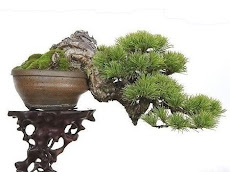
photo by:the-gardener-guy-blog
Because of the toxins associated with fertilizers and pesticides, many people are turning to organic gardening. The Bonsai is one plant that people are adding to their organic gardens. Originating in Asia, bonsai gardening has become very popular throughout the world. Bonsai plants require a lot of loving care. Growing them is often considered an art form.
Organic Soil and Fertilization
The proper soil mixtures and fertilizers are essential for healthy bonsai growth. Research shows that the best bonsai soils are soils that have organic matters. Bonsai soil tends to be a loose, quick-draining mix of natural and non-chemically treated soil. The foundation is a mixture of sand or gravel, fired clay pellets, or shale, which is mixed with an organic compound such as peat or bark. Volcanic clay soils are a preferred selection in Japan. Kadama and Kanuma are two popular choices.
Bonsai trees require a fair amount of organic fertilizer. Fertilizer should only be given to the bonsai after watering. Feeding is usually performed once every two weeks during the summer months, and then reduced to once a month for the remainder of year. Organic fertilizers, organic liquid fertilizers are available at many online organic plant stores. You should call your local plant store to see if they have any organic bonsai supplies in stock. Manure and compost are two examples of organic feeds that can used when growing a bonsai tree. It is important to work organic mixtures into the soil.
You use your own compost in your bonsai organic soil mix. To do this, you will require more than one type of compost. According to most bonsai experts, the best organic bonsai soil mix is 40% compost, 30 % seramis clay granule, and 30% grit.
Watering Your Bonsai
With minimal space in a bonsai pot, careful and frequent attention is required to make sure the tree is adequately watered. Sun, heat and wind can dry bonsai trees in a short time which ca result in permanent damage. You need to know the needs of your particular tree because some trees can survive short periods of dry spells, while others need constant moisture. Deciduous trees are more susceptible to dehydration. Evergreens can appear to handle periods of dry conditions better, but do not display any signs of damage until it is has occurred. One indication of damage is that the leaves will start wilting.
The process of watering is different than how you would normally water regular houseplant. Bonsai trees require submersion of the whole pot in water for several minutes. Once you remove the pot, allow the bonsai to drain. Too much watering can result in root rot and fungal infestations. Free draining soil prevents water-logging. To maintain proper soil, provide water in small amounts frequently because there is a flushing effect when the water is added. Bonsai plants are repotted regularly during their development. This encourages new feeder root growth so that the tree will be able to absorb moisture better. When they mature, they are repotted less often.
Young bonsai, known as potensai, are placed in 'growing boxes.' The large boxes permit the roots to grow which allows for food and water consumption as well as adding life to the tree. When the bonsai has outgrown the 'growing box,' it is then replanted in a 'training box.' This box is smaller allowing for a denser root mass. This makes reorganicplanting the bonsai in its final pot much easier.
Growing bonsai trees can be a very peaceful and spiritual experience. With the right care and trimming techniques, you can grow a beautiful living piece of art.
About Author Amy Nutt :
Organic gardening guide features tips and solutions to common garden issues - Redenta's is committed to a natural and sustainable approach to organic gardening and organic gardening supplies. Visit http://suppliesorganicgardening.com
Article Source: http://www.BharatBhasha.com
Article Url: http://www.bharatbhasha.com/gardening.php/124461



